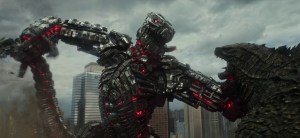There’s a very real tendency in comics to look for subjects of canonization well before their time. It’s hard to blame the industry for this either. American comics are in the midst of emerging from a niche medium to something more widely read, studied, and admired, both as entertainment and art. For a long time the evidence of comics value has rested on the year 1986 with stories like Watchmen and Maus. So finding that next best thing seems to be a consistent theme amongst critics and fans each year.
Videos by ComicBook.com
A.D. After Death is most likely not that next best thing based on Book One. If you read that as a criticism or complaint, it’s not. Not being an absolute masterpiece or a paradigm shifting work isn’t a sin, it’s something 99.99% of comics share. But it’s worth saying when discussing a comic like this with so much hype and hyperbole surrounding it. Those expectations don’t serve it or its creators well, and I hope that this is a comic which will be well served.
Because A.D. After Death is good. In fact, it’s very good.
Scott Snyder and Jeff Lemire first announced the concept at Image Expo in January 2015 as a short standalone graphic novel, but it has since grown into three 72-page comics. It has been well served by both this expansion and separation. The narrative is every bit as its execution. Taking place in at least three distinct timelines, it tells the story of Jonah Cooke, a thief who helped steal the cure for death and now lives in a dystopian future. The world of his past and present are fascinating, but the story is primarily a character study. While questions about what happened to change the world will stick with readers, what resonates most are Jonah’s memories and his relationship to them.
Memories of his childhood and the origin of this “deathless” world are mixed with a present existence in which humans serve decades long roles in a never-ending rotation of jobs. These past experience blur and whorl within the current narrative. Some connections are obvious, while others serve primarily to explore Jonah’s psyche. They are all intended to delve into who he is though, and do an excellent job of crafting mood and theme. Taken as individual elements, separate from the whole, Lemire’s watercolors and Snyder’s prose still sing.

That sort of fragmentation is enhanced by the non-typical structure of A.D. After Death. Rather than rely entirely typical comics form, something that has served both Snyder and Lemire very well, they opt to add standalone watercolors and prose passages. The sections dedicated to comics are as effective as someone familiar with either of their work would expect. Typically rendered in five panels or less with ample splashes, the story is paced thoughtfully and allows Lemire’s art to tell the work. It’s a form they are both familiar with and delivers small emotional moments every bit as well as something like Lemire’s masterful The Underwater Welder. It’s the non-standard elements of the story that strike to impress though.
All of the prose is set in Cooke’s past and spun like a short story, too finely crafted to be a campfire yarn, but familiar enough to come from a friend with a knack for writing. They are journal entries from a well-educated man. In this manner Snyder merges his own skill with writing with the narrative being told by Cooke. Readers unfamiliar with Snyder’s previous work to comics could surely guess at his short story talents based on these passages. He evokes key elements clearly and allows his narrator to wander in the telling just enough for it to feel real. Yet there is a focus to each story being told and the conclusion of each serves as a proper ending that adds meaning to the entire thing.
The choice of which moments to present as prose versus comics is the real trick in Snyder and Lemire’s storytelling though. Tales of observing a goat pass over strange phenomena or a sad family trip to Florida don’t lend themselves to comics as naturally or necessarily as Cooke’s travels in the future. They are stories which cover long tracts of time and often rely on nonspecific events. They also offer imagery that is better imagined than seen. The thought of a head knocking against cement or a hoof split by rot are horrifying and that horror is best maintained through obfuscation instead of the slow play-by-play of panels. Snyder’s precise evocation of these moments is perfect and sets an uneasy mood tha
Lemire is every bit as exacting in his singular images presented alongside these words. Escaping the interplay of panels, he focuses his loose inks and watercolors into singular moments that can tell a story all on their own. Even his figure studies like that of a nubile, wide-eyed goat or a mother and son hand-in-hand manage to straddle a line between joy and dread. Alone they exist as delightful moments, but the mood of A.D. After Death hangs a potent cloud over it all. More complex compositions like an unspooled recording tape connected to an I.V. draws parallels between memories and the impermanence of life. Scanning these images is a reminder of Lemire’s skill with composition and very capable choice of subjects.

It is also worth noting that his watercolor work is pushed beyond anything fans have seen before, even in Trillium. Farmland and mundane memories set a standard palette of browns and greens that allow more fantastical elements to truly soar against expectations later in this first installment. His creation of an otherworldly sky high in our own altitude is breathtaking. Its consistency is as impressive as the array of colors and beautiful whorling shapes they form. If the following books contain more of this scenery, that alone will be worth the price of admission.
Yet the world of A.D. After Death and the story of Jonah Cooke are not lacking in ambition or depth. Cooke’s obsession with death and its impact on his own life stems from memories that read as being entirely unique, while also somehow being universal. It is the slow dawning of realization that all things pass and the awful inevitability of it all. Snyder and Lemire tackle the slow, aching pain not only of losing others, but simply knowing that we will. That is the slow burning mood of this first book and it sets the stage for a potent examination of mortality. The commentary on display here is sharp, but it is also clearly only the start of a thesis statement. What is consistently clear is how intimately personal this work is to those crafting it. The smallness of Cooke’s own life and history, set in our own timeline, speaks to the hard won wisdom and pain of those sharing their stories through him.
The first installment of A.D. After Death is thoughtfully assembled and carefully crafted. It reflects a unique pair of talents and their differing strengths as a collaborative pair. It pushes the boundaries of mainstream comics without reinventing the wheel. It is accessible and exciting on a surface level, while providing a story that is driven by the creators’ personal anxieties and concerns.
Simply put, it’s some damn fine comics.
Isn’t that enough?
Grade: A-
Side note: Naming the main character Cooke and his pet Darwyn is a nice touch and commemoration in a comic about confronting mortality. Well done.









